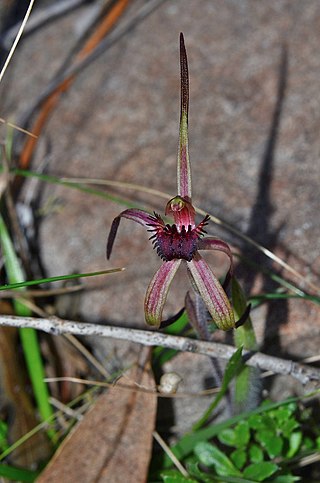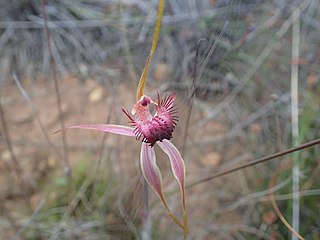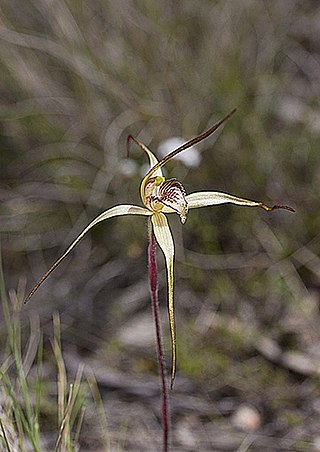Caladenia robinsonii, commonly known as the Frankston spider orchid is a plant in the orchid family Orchidaceae and is endemic to Victoria. It is a ground orchid with a single hairy leaf and one or two red and creamy-yellow flowers with dark red glandular tips on the sepals. In 2010 only about forty specimens of this plant, growing in a single population were known.

Caladenia dimidia, commonly known as the chameleon orchid is a species of orchid endemic to the south-west of Western Australia. It has a single hairy leaf and one or two yellow, cream-coloured or pinkish flowers. It is a variable species, similar to the Joseph's spider orchid but has a more northerly distribution and smaller flowers.

Caladenia amoena, commonly known as charming spider orchid, is a plant in the orchid family, Orchidaceae, and is endemic to Victoria, Australia. It is a ground orchid which grows singly or in small groups, has a single dark green, hairy leaf and a single yellowish-green flower with red stripes. It is only known from a few sites and has been classified as Endangered.

Caladenia caudata, commonly known as tailed spider orchid, is a plant in the orchid family Orchidaceae and is endemic to Tasmania. It is a ground orchid with a single hairy leaf and up to four red, or yellow and red flowers with dark red to almost black tips.

Caladenia clarkiae, commonly known as pink caps, is a plant in the orchid family Orchidaceae and is endemic to south-eastern Australia. It is a ground orchid which grows singly or in small groups in Victoria and New South Wales. It has a single leaf and usually one or two white to pale pink flowers with darker pink tips.

Caladenia clavigera, commonly known as plain-lip spider orchid or clubbed spider orchid is a plant in the orchid family Orchidaceae and is endemic to Australia. It is a ground orchid which grows as scattered individuals or in small colonies in Victoria, New South Wales and South Australia. It has a single leaf and one or two small yellowish-green and red flowers.

Caladenia conferta, commonly known as the crowded spider orchid or coast spider-orchid, is a plant in the orchid family Orchidaceae and is endemic to a restricted area in South Australia. It is a ground orchid with a single hairy leaf, and usually a single yellowish-green flower with red markings on a wiry, hairy stalk.

Caladenia decora, commonly known as the Esperance king spider orchid is a species of orchid endemic to the south-west of Western Australia. It has a single hairy leaf and up to three red, yellow and green flowers. It is a variable species, similar to the king spider orchid and sometimes hybridises with other species so that it can be difficult to recognise, but is one of the largest spider orchids found in Western Australia.
Caladenia dienema, commonly known as the windswept spider-orchid, is a plant in the orchid family Orchidaceae and is endemic to Tasmania. It is a ground orchid with a single, hairy leaf and a single, variably-coloured, usually dark red flower on a thin, wiry stem 5–12 cm (2–5 in) high.

Caladenia echidnachila, commonly known as the fawn spider orchid, is a plant in the orchid family Orchidaceae and is endemic to Tasmania. It is a ground orchid with a single, hairy leaf and one or two fawn-coloured flowers with thin red lines on the sepals and petals.
Caladenia flaccida, commonly known as the flaccid spider orchid, is a plant in the orchid family Orchidaceae and is endemic to eastern Australia. It is a ground orchid with a single hairy leaf and up to three cream-coloured, pinkish or red flowers with long, thread-like, glandular tips on the sepals and petals.
Caladenia helvina, commonly known as the summer spider orchid, is a plant in the orchid family Orchidaceae and is endemic to Tasmania. It is a ground orchid with a single hairy leaf and usually a single greenish-yellow to pale yellow flower with reddish teeth on the sides of the labellum and reddish calli along its mid-line.
Caladenia necrophylla, commonly known as late green-comb spider orchid, is a species of orchid endemic to South Australia. It has a single leaf and a single yellowish-green flower with red lines along the sepals and petals. It is unusual in that the leaf has completely withered before the flower opens, and sometimes even before the flower spike appears.
Caladenia armata is a plant in the orchid family Orchidaceae and is endemic to the Australian Capital Territory. It has a single dull green leaf with purple blotches near the base, and a single cream-coloured to pink flower with red to maroon markings. It is only known from a single population containing fewer than ten plants.
Caladenia branwhitei, commonly known as the Bethungra spider orchid, is a plant in the orchid family Orchidaceae and is endemic to southern New South Wales. It has a single dull green leaf and one or two, usually dark red to maroon-coloured flowers. It is only known from three areas near Bethungra where it grows in ironbark forest.
Caladenia ensigera is a plant in the orchid family Orchidaceae and is endemic to South Australia. It is a ground orchid with a single leaf and one or two greenish cream to whitish green flowers and is only known from Alligator Gorge in the Mount Remarkable National Park.
Caladenia saxatilis is a plant in the orchid family Orchidaceae and is endemic to South Australia. It is a ground orchid with a single hairy leaf and one or two pale creamy-green flowers, sometimes with thin reddish lines. It occurs in the southern Flinders Ranges.
Caladenia strigosa is a plant in the orchid family Orchidaceae and is endemic to South Australia. It is a ground orchid with a single leaf and a single greenish-cream flower with fine reddish streaks. It grows in sandy soil in shrubland.
Caladenia zephyra is a plant in the orchid family Orchidaceae and is endemic to South Australia. It is a ground orchid with a single, densely hairy leaf and a single cream-coloured to very pale yellow flower with blackish glandular hairs on the sepals and petals. It occurs on the Eyre Peninsula but may have a wider distribution.
Caladenia fuliginosa is a plant in the orchid family Orchidaceae and is endemic to the Yorke Peninsula in South Australia. It is a ground orchid with a single hairy leaf and a single relatively large, creamy-yellow flower, sometimes with reddish lines. The flowers have a smell resembling hot metal.








